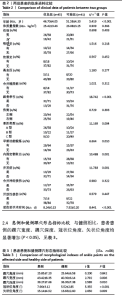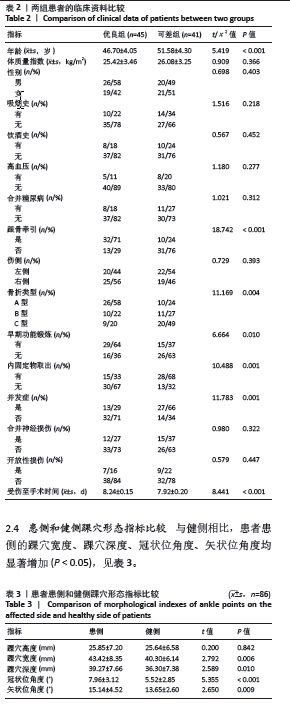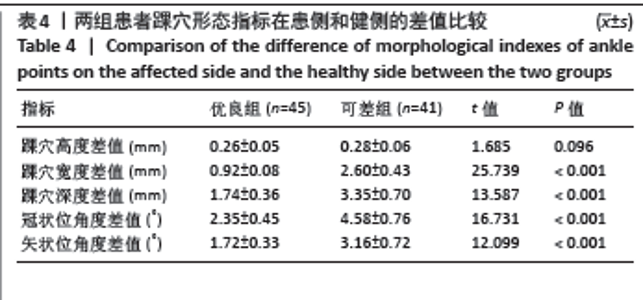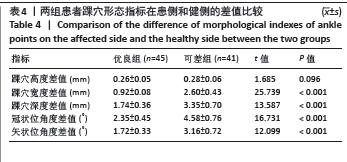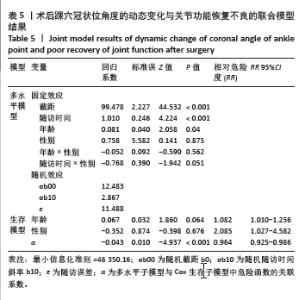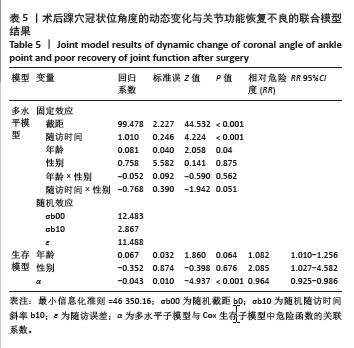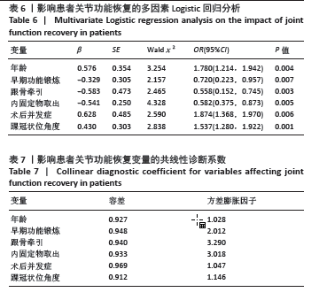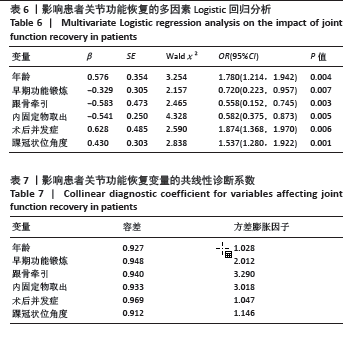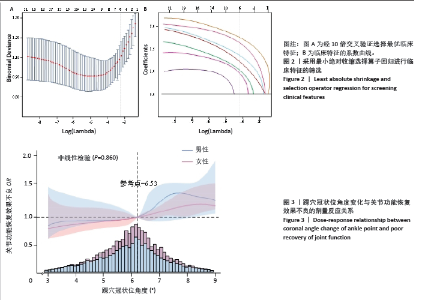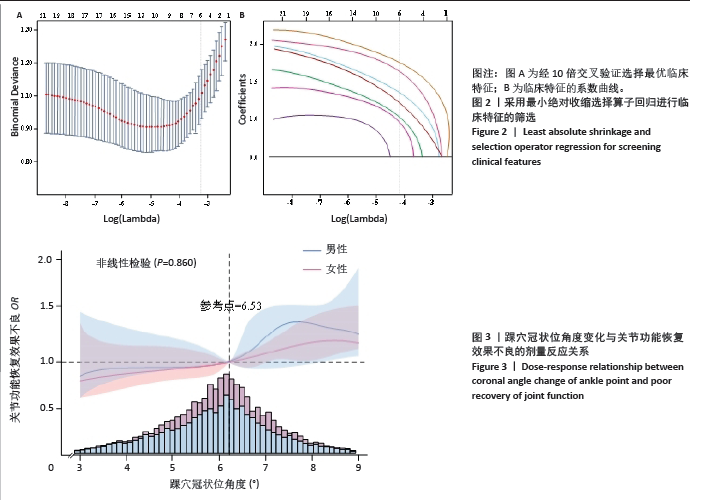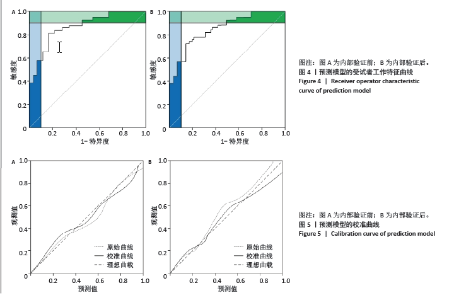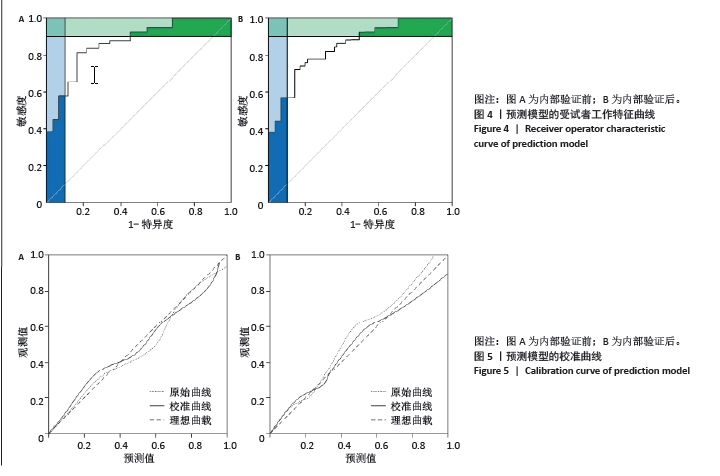Chinese Journal of Tissue Engineering Research ›› 2025, Vol. 29 ›› Issue (9): 1820-1826.doi: 10.12307/2025.131
Previous Articles Next Articles
Relationship between coronal angle fluctuation of ankle point and recovery of joint function after ankle fracture
Liu Yan, Wang Kai, Wu Min
- Department of Orthopedics, Taizhou Hospital of TCM, Taizhou 225300, Jiangsu Province, China
-
Received:2023-11-07Accepted:2024-02-20Online:2025-03-28Published:2024-10-10 -
Contact:Wu Min, Associate chief physician, Department of Orthopedics, Taizhou Hospital of TCM, Taizhou 225300, Jiangsu Province, China -
About author:Liu Yan, Associate chief physician, Department of Orthopedics, Taizhou Hospital of TCM, Taizhou 225300, Jiangsu Province, China
CLC Number:
Cite this article
Liu Yan, Wang Kai, Wu Min. Relationship between coronal angle fluctuation of ankle point and recovery of joint function after ankle fracture[J]. Chinese Journal of Tissue Engineering Research, 2025, 29(9): 1820-1826.
share this article
Add to citation manager EndNote|Reference Manager|ProCite|BibTeX|RefWorks
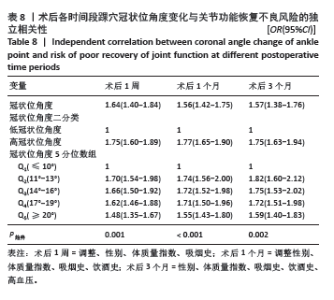
2.8 踝关节骨折患者术后踝穴冠状位角度变化对关节功能恢复的独立相关性 Logistic回归模型结果显示,术后3个月内的冠状位角度变化与关节功能恢复效果不良风险存在独立相关性(OR=1.57,95%CI:1.38-1.76,P=0.002)。与较低冠状位角度比较,较高的冠状位角度变化与关节功能恢复效果不良风险存在独立相关性(OR=1.75,95%CI:1.63-1.94,P=0.001)。与Q1组比较,随着冠状位角度逐渐增大(Q2-Q5),相关性效应值分别为(OR=1.82,95%CI:1.60-2.12,P=0.160)、(OR=1.75,95%CI:1.53-2.02,P=0.052)、(OR=1.72,95%CI:1.51-1.98,P=0.022)、(OR=1.59,95%CI:1.40-1.83,P < 0.001),趋势性检验存在统计学意义(P趋势< 0.001),见表8。"
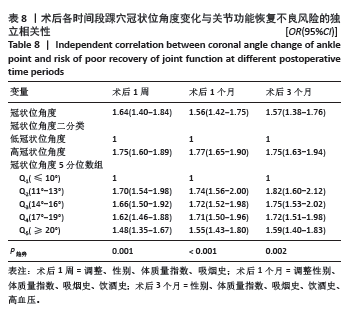
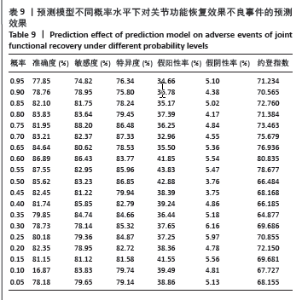
2.10 建立预测模型 构建关节功能恢复效果不良事件发生的预测模型。多因素Logistic回归模型进行预测,将上述结果放入到回归方程y=1-1/(1+e-z)中,得到关节功能恢复效果不良事件预测的公式:P=1-1/(1+e0.372a-0.246b-0.568c-0.615d+1.147f+2.013g),其中,a=关节功能恢复效果,b=年龄过大,c=早期功能锻炼缺乏,d=无跟骨牵引,f=内固定物未取出,g=术后并发症。利用回归方程计算关节功能恢复效果不良事件发生的可能性,结果可知:P=0.60时,约登指数的数值最大,为80.835。表明模型预测效果较好。当P > 0.55时,表示踝关节骨折患者可能会出现关节功能恢复效果不良事件。此模型预测准确度为86.89%,敏感度、特异度为86.43%及83.77%。见表9。"
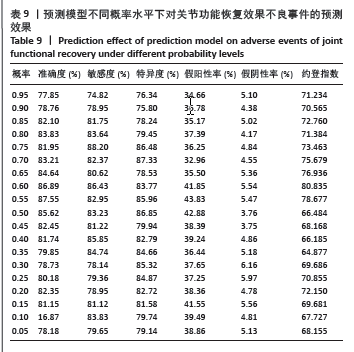
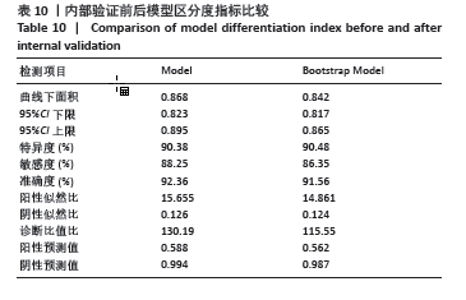
2.11 模型评价 验证上述预测模型的准确度。以患者实际是否发生关节功能恢复效果不良事件为状态变量,构建受试者工作特征曲线及校准曲线,并计算曲线下面积、预测概率及关节功能恢复效果不良的平均绝对误差,结果显示,内部验证前后的曲线下面积分别为0.868(95%CI:0.823-0.895)和0.842(95%CI:0.817-0.865),敏感度分别为88.25%及86.35%,特异度分别为90.38%及90.48%,平均绝对误差均为0.009,说明该模型有较高的区分度和校准度,且灵敏度和特异度良好,见图4,5及表10。 2.12 植入物与宿主的生物相容性 此次研究中所有患者均未发生植入物周围感染等局部反应、过敏反应及排斥反应,生物材料和植入物置入患者体内后无不良反应。"
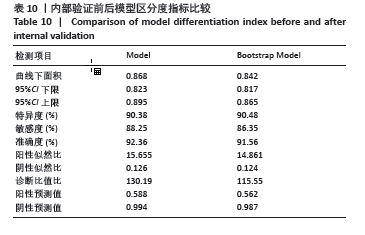
| [1] 刘玉波, 张会增, 张同润, 等. 踝关节骨折术后踝穴形态变化与踝关节功能的相关因素分析[J]. 中国组织工程研究,2022,26(3): 440-445. [2] 薛浩文, 褚虹宇, 左解鹏, 等. 基于CT的中国正常成人踝关节三维形态学分析及应用研究[J]. 中国临床解剖学杂志,2021,39(5): 539-545. [3] ICHIKAWA K, JIANG Y, SUGI M, et al. Joint angle based motor point tracking stimulation for surface FES: A Study on biceps brachii. Med Eng Phys. 2021;88(2):9-18. [4] CHUMACERO-POLANCO E, YANG J. Validation of an ankle-hip model of balance on a balance board via kinematic frequency-content. Gait Posture. 2020;82(11):313-321. [5] LIU Y, WANG C, ZHENG L, et al. Correlation Between Postoperative Morphologic Changes of Ankle Mortise and Ankle Joint Function After Pilon Fracture. Int J Surg. 2020;104(3-4):182-187. [6] UZUN E, MISIR A, KIZKAPAN TB, et al. Mid-term functional, clinical, and radiological outcomes with factors affecting revision of mobile-bearing medial unicompartmental knee arthroplasty. Knee. 2020;27(2):527-534. [7] MATSUURA Y, TAKAMURA T, SUGIURA S, et al. Evaluation of anterior oblique ligament tension at the elbow joint angle-a cadaver study. J Shoulder Elbow Surg. 2021;30(2):359-364. [8] HIRAO M, HASHIMOTO J, EBINA K, et al. Radiographic effects observed in the coronal view after medial malleolar osteotomy at total ankle arthroplasty in rheumatoid arthritis cases. J Orthop Sci. 2020;25(6):1072-1078. [9] COOKE ME, TORNETTA P, FIROOZABADI R, et al. Open Ankle Fractures: What Predicts Infection? A Multicenter Study. J Orthop Trauma. 2022;36(1):43-48. [10] 李亚星, 任毅, 唐霞, 等. 特殊命名的踝关节骨折及其诊疗要点[J]. 中华骨科杂志,2019,39(21):1344-1356. [11] 袁心伟, 张斌, 胡豇, 等. 金属螺钉与可吸收螺钉修复下胫腓韧带复合体近期疗效比较[J]. 中国修复重建外科杂志,2022,36(8): 989-994. [12] HERNANDEZ-CASTILLEJO LE, ÁLVAREZ-BUENO C, GARRIDO-MIGUEL M, et al. The effect of hallux valgus open and percutaneous surgery on AOFAS scale: a systematic review and meta-analysis. Qual Life Res. 2021;(1):1-10. [13] 杨衡, 陈宇, 弋卓君, 等. 小切口联合全修复策略治疗Lauge-Hansen旋前-外旋型Ⅳ度踝关节闭合骨折[J]. 中国修复重建外科杂志,2020,34(6):730-736. [14] BRAUNSTEIN M, BAUMBACH SF, URRESTI-GUNDLACH M, et al. Arthroscopically Assisted Treatment of Complex Ankle Fractures: Intra-articular Findings and 1-Year Follow-Up - ScienceDirect. J Foot Ankle Surg. 2020;59(1):9-15. [15] 陈烽, 安忠诚, 周芳, 等. 后踝固定与否对不同Haraguchi分型后踝骨折疗效的影响[J]. 中国修复重建外科杂志,2021,35(6): 722-728. [16] 罗刚, 倪卫东, 郭世航, 等. 缝合锚修复三角韧带深层治疗混合型内侧损伤踝关节骨折疗效观察[J]. 中国修复重建外科杂志,2020, 34(11):1387-1391. [17] 韩翔, 李佳伟, 张俊忠. 后外侧联合内侧入路切开复位内固定治疗旋后外旋型三踝骨折[J]. 临床骨科杂志,2022,25(6):885-889. [18] 黄培镇, 董航, 蔡群斌, 等. 三角韧带修复与下胫腓联合螺钉固定治疗三角韧带损伤的旋后外旋型Ⅳ度踝关节骨折的近期疗效观察[J]. 重庆医学,2019,48(6):1065-1068. [19] 张绍春, 周彬, 王冶, 等. TightRope带袢钢板与皮质骨螺钉内固定治疗踝关节骨折合并的下胫腓联合损伤疗效比较[J]. 中国骨与关节损伤杂志,2021,36(12):1262-1265. [20] LARRAINZAR-GARIJO R, MOLANES-LOPEZ EM, MURILLO-VIZUETE D, et al. Mechanical Alignment in Knee Replacement Homogenizes Postoperative Coronal Hip-Knee-Ankle Angle in Varus Knees: A Navigation-Based Study. J Knee Surg. 2022;35(12):1285-1294. [21] 吴国忠, 王文怀, 陈守勃, 等. 关节镜下改良后踝入路切除治疗成人疼痛性跟距骨桥[J]. 中国修复重建外科杂志,2020,34(1):46-52. [22] 邱范基, 李金峰. 不同模式本体感觉神经肌肉促进技术干预对功能性踝关节不稳者平衡能力的影响[J]. 中国康复医学杂志,2022, 37(6):773-778. [23] 袁文杰, 陆大明, 徐雪平, 等. 经腓骨后外侧入路和经腓骨入路内固定术治疗旋后外旋型Ⅳ度踝关节骨折的疗效比较[J]. 中华骨与关节外科杂志,2023,16(2):164-168. [24] 季磊, 汪玉海, 李卫华, 等. 不同入路内固定术治疗旋后外旋型Ⅳ度踝关节骨折的疗效比较[J]. 中国运动医学杂志,2020,39(4):263-267. [25] 李朋斌, 陈伟, 邢焕霞, 等. 两种外侧入路接骨板内固定治疗SandersⅢ型跟骨关节内骨折的疗效比较[J]. 中华创伤杂志, 2020, 36(8):698-703. [26] ZHAO HZ, FAN TS, WANG SL, et al. Closed Reduction for the Treatment of Grade IV Supination-External Rotation Fracture of the Ankle Joint: A Retrospective Analysis. Orthop Surg. 2021; 13(7):2163-2169. [27] KONRADS C, AHREND MD, BEYER MR, et al. Rotation osteotomy of the distal femur influences coronal femoral alignment and the ischiofemoral space. Arch Orthop Trauma Surg. 2022; 142(5):711-720. [28] 尹岳桐, 朱光宇, 田向东, 等. 胫骨结节远端单平面截骨对踝关节冠状面角度的影响[J]. 中国组织工程研究,2024,28(21):3349-3354. [29] NI M, SUN T, ZHANG T, et al. Quantitative initial safety range of early passive rehabilitation after ankle fracture surgery. Injury. 2022;53(6):2281-2286. |
| [1] | Wang Juan, Wang Guanglan, Zuo Huiwu. Efficacy of exercise therapy in the treatment of anterior cruciate ligament reconstruction patients: #br# a network meta-analysis #br# [J]. Chinese Journal of Tissue Engineering Research, 2025, 29(8): 1714-1726. |
| [2] | Jiang Tao, Zhang Chuankai, Hao Liang, Liu Yong. MAKO robot- and navigation-assisted knee replacement: comparison of lower limb force alignment and prosthesis position accuracy [J]. Chinese Journal of Tissue Engineering Research, 2025, 29(33): 7150-7157. |
| [3] | Pan Hao, Yang Meng, Liu Guoqiang. Timing of total knee arthroplasty with tourniquet under navigation system: a single-center, retrospective analysis [J]. Chinese Journal of Tissue Engineering Research, 2025, 29(15): 3159-3164. |
| [4] | Kong Changgeng, Guo Xiang, Wu Duoqing, Huang Youhua, Wang Congren, Fu Huisi, Fan Zhongcheng, Chen Bo, Shen Hui. Suture anchor and medial malleolus repair in treatment of injury in the deep layer of deltoid ligament [J]. Chinese Journal of Tissue Engineering Research, 2025, 29(15): 3193-3198. |
| [5] | Chen Wenhan, Men Jie, Yang Wei, Zhao Xiaoyu. Effect of vibration therapy combined with suspension training on movement and knee joint function after anterior cruciate ligament reconstruction [J]. Chinese Journal of Tissue Engineering Research, 2025, 29(11): 2225-2230. |
| [6] | Wang Xiao, Zhang Fan, Lin Lupan, Qi Tianxu, Lin Fuqing. Reverse design of a new type of low-profile lateral malleolus steel plate assisted by computer bioengineering technology [J]. Chinese Journal of Tissue Engineering Research, 2024, 28(30): 4800-4805. |
| [7] | Li Luyi, Li Xiaojie, Hei Zeming, Liu Hua. Effect of graft type on knee function after anterior cruciate ligament reconstruction [J]. Chinese Journal of Tissue Engineering Research, 2024, 28(17): 2753-2758. |
| [8] | Bai Jiangbo, Gao Ruijiao, Zhang Aru, Yu Kunlun, Zhang Chunhuan, Tian Dehu. Percutaneous screw fixation with a novel guide for the treatment of scaphoid fractures [J]. Chinese Journal of Tissue Engineering Research, 2024, 28(12): 1885-1889. |
| [9] | Zheng Hongrui, Zhang Wenjie, Wang Yunhua, He Bin, Shen Yajun, Fan Lei. Femoral neck system combined with platelet-rich plasma in the treatment of femoral neck fracture [J]. Chinese Journal of Tissue Engineering Research, 2023, 27(9): 1390-1395. |
| [10] | Cheng Shuai, Jiang Shanyong, Lu Jianshu, Ji Xubin. Effect of internal fixation of ulnar styloid process base fracture on wrist function [J]. Chinese Journal of Tissue Engineering Research, 2023, 27(36): 5840-5844. |
| [11] | Chen Peng, Wang Ling, Dong Shiyu, Ding Yue, Jia Shaohui, Kou Xianjuan, Zheng Cheng. Effects of whole-body vibration training on anterior cruciate ligament reconstruction: a meta-analysis [J]. Chinese Journal of Tissue Engineering Research, 2023, 27(36): 5875-5883. |
| [12] | Fang Run, Ning Rende, Liu Yulong, Bi Chenghao, Zhou Daobin. Significance of X-ray measurement of the anatomical relationship between adult lateral tibial plateau and lateral femoral condyle in fracture reduction [J]. Chinese Journal of Tissue Engineering Research, 2023, 27(13): 2076-2080. |
| [13] | Liu Yubo, Zhang Huizeng, Zhang Tongrun, Sui Gengyi, Ma Nan, Cheng Xu, Gao Xupeng, Xu Jing, Wang Chaoliang. Correlation analysis between the morphological changes of ankle acupoints and the ankle function after ankle fracture surgery [J]. Chinese Journal of Tissue Engineering Research, 2022, 26(3): 440-445. |
| [14] | Xia Peige, Yin Li, Wang Haitao, Zhang Yi, Qiao Renqiu, Kong Zhiheng, Zhao Hongbo, Shi Xiangyu. Effect of knee ligamentous laxity on patient satisfaction after total knee arthroplasty: a medium to long-term follow-up [J]. Chinese Journal of Tissue Engineering Research, 2022, 26(15): 2323-2329. |
| [15] | Chai Le, Ding Xiao, Wang Bin, Chen Xu, Guo Jiarui, Zhu Guangpu, Yu Jinwei . Effect of platelet-rich plasma with bioceramic system on the treatment of ARCO stage II osteonecrosis of the femoral head [J]. Chinese Journal of Tissue Engineering Research, 2022, 26(15): 2347-2351. |
| Viewed | ||||||
|
Full text |
|
|||||
|
Abstract |
|
|||||


